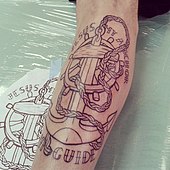
Back Tatoeëermerk Afrikaans Tatuache AN وشم ARZ Tatuaxe AST Tutang BJN উল্কি Bengali/Bangla Tetování Czech Tatovering Danish Tätowierung German Tätoveering Estonian



A tattoo is a form of body modification made by inserting tattoo ink, dyes, and/or pigments, either indelible or temporary, into the dermis layer of the skin to form a design. Tattoo artists create these designs using several tattooing processes and techniques, including hand-tapped traditional tattoos and modern tattoo machines. The history of tattooing goes back to Neolithic times, practiced across the globe by many cultures, and the symbolism and impact of tattoos varies in different places and cultures.
Tattoos may be decorative (with no specific meaning), symbolic (with a specific meaning to the wearer), pictorial (a depiction of a specific person or item), or textual (words or pictographs from written languages). Many tattoos serve as rites of passage, marks of status and rank, symbols of religious and spiritual devotion, decorations for bravery, marks of fertility, pledges of love, amulets and talismans, protection, and as punishment, like the marks of outcasts, slaves and convicts. Extensive decorative tattooing has also been part of the work of performance artists such as tattooed ladies.
Although tattoo art has existed at least since the first known tattooed person, Ötzi, lived around the year 3330 BC, the way society perceives tattoos has varied immensely throughout history. In the 20th century, tattoo art throughout most of the world was associated with a limited selection of specific "rugged" lifestyles, notably sailors and prisoners. Today,[when?] people choose to be tattooed for artistic, cosmetic, sentimental/memorial, religious, and spiritual reasons, or to symbolize their belonging to or identification with particular groups, including criminal gangs (see criminal tattoos) or a particular ethnic group or law-abiding subculture. Tattoos may show how a person feels about a relative (commonly a parent or child) or about an unrelated person.[1]
Tattoos can also be used for functional purposes, such as identification, permanent makeup, and medical purposes.
- ^ Johnson, Frankie J (2007). "Tattooing: Mind, Body And Spirit. The Inner Essence Of The Art". Sociological Viewpoints. 23: 45–61.
© MMXXIII Rich X Search. We shall prevail. All rights reserved. Rich X Search